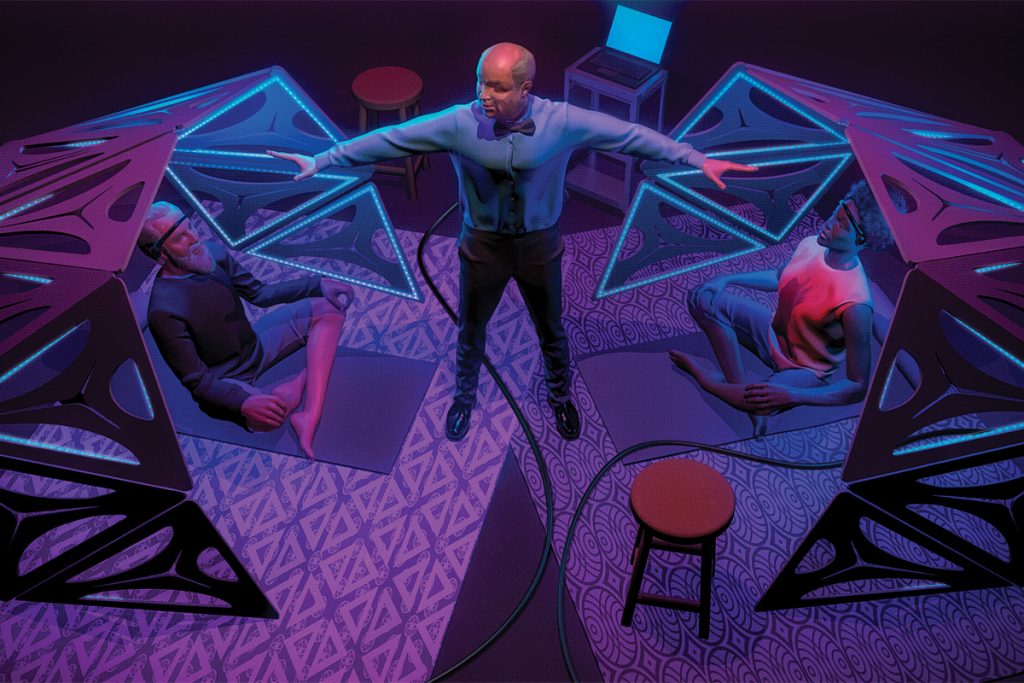Cheering crowds, flashing lights, high-tech scoring, and a carnival barker directing the action against the backdrop of a bustling festival—and at the center of it all, two competitors face off for the top score. The name of the game? “Relax harder.”
Welcome to Meditation Deathmatch, a pop-up exhibition that is equal parts art installation, sporting event, and science experiment. Participants are placed under visualizers—crescent-shaped panels that create brilliant light displays according to an algorithm that tracks brainwaves—and instructed to meditate for four minutes while the emcee dishes out distractions and encourages the crowd to do the same. Meanwhile, electroencephalogram (EEG) headbands record the participants’ brainwaves to determine who can attain the calmest state.
Related: This Is Your Brain On Zen
The idea for the project came from a group of neuroscience researchers and artists in Austin, Texas, who started building the system for a meditation competition in early 2014. That summer, they brought the finished product to Burning Man, the annual pop-up arts festival in the Nevada desert. Setting up their EEG readers next to the popular Thunderdome installation—where festivalgoers fight in a remake of the steel-cage arena from the Mad Max film—they challenged people to enter the Thunder OM and take part in a Meditation Deathmatch.
“It’s tongue in cheek,” said Brey Tucker, who joined up with the group at Burning Man before he and two others created their own iteration of Meditation Deathmatch, which debuted at the Bass Coast electronic music and arts festival outside of Vancouver, Canada, in 2018. “But at the end of the experience, someone’s been very subtly shown the power of meditation. A lot of meditation is very dull, and you really have to be patient to see the benefits from it. So when I first saw this, I thought it was an absolutely hilarious way to get people into something that’s otherwise not very exciting.”
Tucker, the technology director at a Vancouver construction firm, was joined by Alyssa Haas, whose background is in industrial design and architecture, and Greg Borreson, a programmer who helps develop educational games at an independent studio in Vancouver. Together they built a new system and introduced the visualizer pods, which react to participants’ brainwave readings. If a meditator is calmer than their opponent, the pods produce a bigger, brighter, more distracting lightshow to make meditating more challenging, leveling the playing field. The winner is the contestant who has the highest level of alpha and theta waves, which are associated with being calm and having a clear mind, and the lowest level of beta and gamma waves, associated with actively trying to concentrate and sensory distractions. (Delta waves, which can be associated with sleep, were ignored for the sake of the competition, and theta and gamma waves count for double.)
Borreson, who designed the visualizer and the scoring program, said that the system is not perfect but offers the best metrics presently available. “Measuring meditation is something where there’s always going to be just straight off physiological differences between people,” he said. Still, some interesting trends emerged.
The highest scorer among the hundreds who participated at the Bass Coast Festival was a Kundalini yoga teacher. In general, people with a meditation practice fared better, as did those who were “commonly described by their friends as being really chill individuals,” Borreson said.
“At the end of the experience, someone’s been very subtly shown the power of meditation.”
Haas said that confidence was a predictor as well. “Often people who were like, ‘Oh, I’m horrible at meditating,’ didn’t do very well,” she noted. Borreson added, “My hypothesis is that they may have been on edge about the particular experience, and it was showing in their gamma dominance. They had a harder time getting comfortable, were more distracted, and were more worried about how well they were doing.”
Haas was also surprised to learn that some children were naturally inclined toward meditation, while others were not.
In addition to the Thunder OM team, the Deathmatch crew, and a third offshoot based in San Francisco called the Meditation Battle League (MBL), other independent meditation competitions have sprouted up. Greater access to neurofeedback technology has been one of the drivers of this trend. Products like the Muse Brain Sensing headband costs about $200, and various meditation apps let people track their own performance.
Earlier this year, Chris Taylor, a writer for the media and entertainment website Mashable, ran March Mindfulness (a take on March Madness) and found that a “calmness” competition could spur people who were typically stressed out about the prospect of meditating to take part. After the final round on March 31 at the San Francisco headquarters of the meditation app Calm, Taylor wrote that competitive meditation could be “a genuine sport in the making.” It’s unclear, however, how widespread the trend has become.
Yet Deathmatch seems to be unique in using spectacle to deliberately distract its participants. Borreson said he was not familiar with the other competitions but said that watching those would probably be like following “tennis or golf ”—whereas their own game, Haas chimed in, was “like WWE” wrestling.
The team said that the next step would be to create a more mobile version of the currently bulky Meditation Deathmatch setup in order to be able to tour with it more regularly. Deathmatch, MBL, and Thunder OM are also in talks to collaborate.
“Going forward, we’re hoping to connect the various groups and try to make sure that whenever the name Meditation Deathmatch is used, it is backed by a certain amount of shared vision and a standard of performance,” said Joshua Jackson, a member of the original Thunder OM team. Jackson said he has begun to collaborate with Meditation Battle League and was impressed by their enthusiasm.
“It’s just the first chapter,” said Tucker. “So I think you can definitely expect more from us.”
Thank you for subscribing to Tricycle! As a nonprofit, we depend on readers like you to keep Buddhist teachings and practices widely available.
